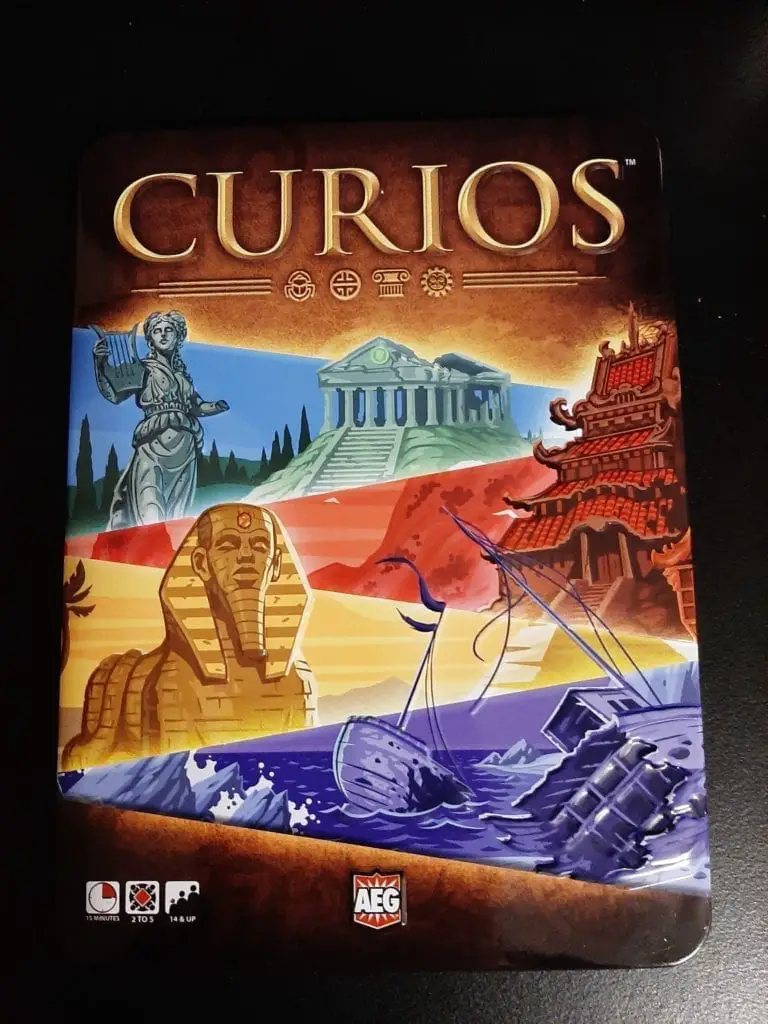2-5 players
Ages 14+
~15 minutes per game
The Overview:

This game is a fun mix of Clue and Deal or No Deal, where players send Archaeologists to different locations: The Forbidden Tomb, The Lost Shipwreck, The Great Pyramid, and The Ancient Colosseum. Players compete to get the most Artifacts from each location, but the more players who try to explore a location, the more Archaeologists are required. The fun twist of the game revolves around the Market Cards. Each location has four cards (1,3,5,7) that tell how much each Artifact from that location is worth. These are shuffled and randomly assigned to each location, so it isn’t until each card is revealed at the end that each player knows how much their Artifacts are actually worth. Players get a few cards in their hand, so each person has inside knowledge of Locations. If you have the 7 for The Ancient Colosseum, then you know that it probably isn’t worth it to send your people there. This is what leads to the main strategies of “Do I raid one place as much as possible?” vs “Do I explore a little of each place?” You could get to the end of the game and realize all of your Artifacts from The Great Pyramid are only worth 1 point each, while your opponent’s Artifacts from The Lost Shipwreck added up to a 7 point each blowout. The difference in these two strategies, combined with the random assignment of the Market Cards, means that every time you play this game, it is pretty much guaranteed to be a completely difference experience.
The Set-up:
The game box contains 4 Location cards, 16 Market Cards (4 per Location), 4 sets of 14 Artifact gems (1 set per Location), 5 sets of 7 Archaeologists (1 color per player), and the 1st Player Token (a beautifully made bronze bell, which I immediately wanted to steal to use in other games).
For set-up, each Location card is placed on the table and then randomly assigned a face-down Market Card. The remaining Market Cards are shuffled out to the players as their hand (for smaller groups, there is also a side deck that is made as well). Based on the number of players, Artifacts are placed alongside the Locations. The first player gets the “Best Monopoly Piece Ever Made” bronze bell, which then transfers clockwise after every round.

Gameplay:

I found the gameplay to be as simple and straightforward as the set-up. I immediately went into the paranoid mindset of “Wait, they are taking a lot of Pyramid Artifacts. Does that mean that they know it is high, or that they just want a lot of smaller points?” It was fun in the most hectic, suspicious way possible.
I played two games, winning the first and losing the second. Each time was way more fun than 10 minutes should be. Once the players got the hang of the gameplay, we would have rounds that lasted less than a minute. We already decided that this game would join Coup as “Game Night Warm-up” due to how quickly we all got into it.
As a big fan of strategy games, this simple game really fulfilled my love of planning. For instance, I started the second game with three of the Colosseum cards in my hand: 1, 3, and 7. I immediately knew that every Artifact from The Ancient Colosseum was worth 5 points each. This had the gears in my head quickly spinning while I tried to decide if I should send all of my Archaeologists there for the guaranteed good points. This would lead to opponents assuming I knew something worthwhile was there, which would inevitably make them send their people there as well to try to steal the loot before me. I decided to send a few pawns each round to gather some steady points while also exploring the other areas. And all of this thinking happened before any pieces were played, simply from the set-up and the knowledge that each player gets at the start.
This gameplay also had me thinking about the possible sabotage strategies I could make. If I knew that The Forbidden Temple had to have 1-point Artifacts, I could make a big push at the start to gather some pieces, making it seem like I knew something good was there. If this worked, other players would then start wasting rounds beating me to it, while I spent the rest of my time focusing on other Locations. Like I said, this simple game has a ton of replay ability and strategizing to it. And if you don’t care for the strategy, then I will admit that I sent a lot of Archaeologists to the Shipwreck purely because it looked cool. So, there is always that way to play as well!
In Summary:

Overall, I was honestly impressed with this game. It only has a few pieces, a tiny rule book, and a basic premise to it. As I am writing this review, I am already planning on asking my players to do another round or two with me purely because of how addicting the game is. The games I played were with the same people, but they all went incredibly different ways simply due to the randomness and strategy each person brought into it. This game definitely solidified a spot on my Go-To shelf of games, and I can see us going back to this again and again for quick rushes of hectic gameplay.
[rwp_box id=”0″]
Big thanks to AEG for the copy used in this review. You can pick up Curios on Amazon or AEG’s store, where it retails for $17.88.

